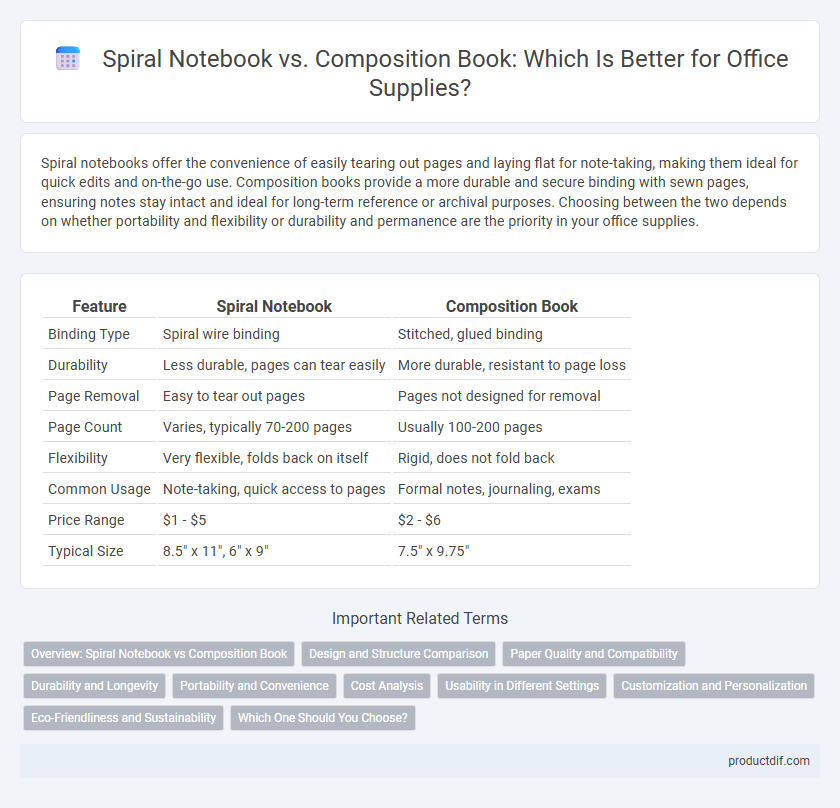Spiral notebooks offer the convenience of easily tearing out pages and laying flat for note-taking, making them ideal for quick edits and on-the-go use. Composition books provide a more durable and secure binding with sewn pages, ensuring notes stay intact and ideal for long-term reference or archival purposes. Choosing between the two depends on whether portability and flexibility or durability and permanence are the priority in your office supplies.
Table of Comparison
| Feature | Spiral Notebook | Composition Book |
|---|---|---|
| Binding Type | Spiral wire binding | Stitched, glued binding |
| Durability | Less durable, pages can tear easily | More durable, resistant to page loss |
| Page Removal | Easy to tear out pages | Pages not designed for removal |
| Page Count | Varies, typically 70-200 pages | Usually 100-200 pages |
| Flexibility | Very flexible, folds back on itself | Rigid, does not fold back |
| Common Usage | Note-taking, quick access to pages | Formal notes, journaling, exams |
| Price Range | $1 - $5 | $2 - $6 |
| Typical Size | 8.5" x 11", 6" x 9" | 7.5" x 9.75" |
Overview: Spiral Notebook vs Composition Book
Spiral notebooks feature a durable metal coil binding that allows pages to lay flat or fold back fully, ideal for easy note-taking and page removal. Composition books have a sewn binding with marbled covers, offering long-lasting durability and a traditional appearance preferred for formal note-keeping. Both options serve distinct purposes depending on user preferences for flexibility and sturdiness in office or school settings.
Design and Structure Comparison
Spiral notebooks feature wire bindings that allow pages to lay flat or fold back, enhancing ease of note-taking and page removal, whereas composition books employ sewn bindings for a more durable, tamper-resistant structure. The design of spiral notebooks offers perforated pages for clean detachment, contrasting with the fixed pages in composition books designed for permanent record-keeping. Spiral notebooks typically present a flexible, customizable cover while composition books maintain a rigid, hard cover with classic marbled patterns for added protection and traditional aesthetic.
Paper Quality and Compatibility
Spiral notebooks typically use thinner, more flexible paper ideal for note-taking and easy page removal, while composition books feature thicker, more durable paper better suited for long-term archival and heavy writing. Compatibility with writing instruments varies, as composition paper handles ink and pressure from various pens and pencils without bleeding or tearing, whereas spiral notebook paper may show ink bleed-through depending on thickness. Choosing between the two depends on the need for portability and page management versus archival durability and writing surface strength.
Durability and Longevity
Spiral notebooks feature a durable metal coil binding that allows pages to lie flat and withstand frequent use without tearing easily, making them ideal for dynamic note-taking environments. Composition books use a sturdy sewn binding and thick covers that protect pages from wear and prolong the notebook's lifespan, ensuring reliable preservation of notes over time. Both options offer durability, but spiral notebooks excel in flexibility, while composition books provide enhanced longevity and resistance to damage.
Portability and Convenience
Spiral notebooks offer superior portability with their flexible binding, allowing pages to fold back completely, which is ideal for on-the-go note-taking. Composition books feature a sturdy, sewn binding that keeps pages secure but limits ease of handling in tight spaces. For convenience, spiral notebooks provide quick page removal and easy organization, while composition books maintain durability and a classic design, making them less versatile for portable use.
Cost Analysis
Spiral notebooks generally offer a lower cost per unit and greater availability in bulk purchases compared to composition books, making them a budget-friendly option for large-scale office needs. Composition books tend to have a higher initial price but provide superior durability with sewn bindings that extend lifespan, reducing replacement frequency over time. Evaluating the total cost of ownership involves balancing the upfront savings of spiral notebooks against the long-term value and durability of composition books.
Usability in Different Settings
Spiral notebooks offer flexible page turning and easy removal, making them ideal for dynamic environments like classrooms and meetings where quick note access is essential. Composition books provide a more durable, bound format, suited for formal settings and archival purposes where maintaining organized, permanent records is important. Both options cater to different usability needs, with spiral notebooks enhancing convenience and composition books ensuring long-term durability.
Customization and Personalization
Spiral notebooks offer extensive customization options, including personalized covers, varied sizes, and multiple binding colors, allowing for tailored organizational needs. Composition books typically feature a fixed design with limited personalization choices but can be enhanced with custom labels or stickers for individual identification. Both options cater to distinct preferences, with spiral notebooks excelling in versatile personalization and composition books providing durable, classic styles.
Eco-Friendliness and Sustainability
Spiral notebooks often feature plastic coils and laminated covers that can hinder recyclability, while composition books typically use cardboard covers and a sewn binding, making them more eco-friendly options. Composition books generally utilize recycled paper and avoid plastic components, enhancing their sustainability credentials. Choosing composition books reduces plastic waste and supports environmentally responsible office supply choices.
Which One Should You Choose?
Spiral notebooks offer easy page removal and lay flat for convenient note-taking, making them ideal for students and professionals who need flexibility and organization. Composition books feature sturdy sewn bindings that prevent pages from falling out, providing durability and better protection for long-term storage and archival purposes. Choose a spiral notebook for frequent editing and quick access, while a composition book is best for keeping permanent, well-preserved records.
Spiral Notebook vs Composition Book Infographic

 productdif.com
productdif.com